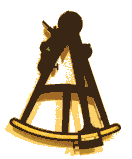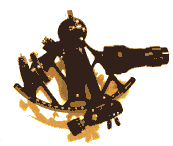
Celestial Navigation
Weekend
June 6-8, 2008
Mystic Seaport
Planetarium

|
|
Celestial Navigation
Weekend |
|
For inquiries or to make a reservation,
please use our contact form: www.fer3.com/Mystic2008/contact
(Note:
please do not attempt to send direct email to addresses at fer3.com
--use the contact form).
UPDATED:
The Planetarium at Mystic Seaport in conjunction with the "NavList" online community is pleased to announce the second biennial "Navigation Weekend" devoted to preserving the art and practice of celestial navigation and nautical astronomy, to be held at Mystic Seaport in Mystic, Connecticut Friday through Sunday, June 6,7,8, 2008.
In an era where most navigation at sea is done by GPS and other electronic means, a vibrant community of historians and enthusiasts preserve the art of using the Sun and Moon and the stars and planets to navigate across the globe. Celestial navigation enthusiasts and practitioners as well as professional and private historians of science will be meeting to discuss the history and future of celestial navigation. Many participants in the "Navigation Weekend" are members of the "NavList" online discussion group which is committed to traditional methods of navigation and position-finding (information page for NavList: www.fer3.com/NavList).
The "Navigation Weekend" will include special presentations and demonstrations by invited speakers on historical navigation methods including the "method of lunars" or "lunar distances" which was once the epitome of the navigator's art. Aspects of sextant use and adjustment will also be discussed, and there will be opportunities to take sights from nearby coastal locations using sextants and other traditional navigational instruments. We're also celebrating fiftieth anniversary of the modern Nautical Almanac, the essential reference for celestial navigation.
| SCHEDULE OF EVENTS: |
FRIDAY June 6, 2008: 12:00
Noon 12:45 [time changed] 1:30pm [time changed]
3:15
4:00
4:45 [updated]
6:00
7:00 10:00 [cancelled, for now] Note: For those who would like to arrive at Mystic Seaport early on Friday (before noon), we will be conducting a basic guided walking tour starting at 10:30am. The tour will depart from the lobby of the Planetarium at 10:30 and return by noon for the beginning of the main activities of the Navigation Weekend (paid admission to Mystic Seaport or membership required). SATURDAY June 7, 2008 10:30am 11:30
12:15 [location changed]
2:00pm
3:15
4:00
4:45 [new addition]
7:00
8:00 SUNDAY June 8, 2008
12:00 Noon
12:45
2:00 2:45 [small change] |
INTERESTED IN GIVING A PRESENTATION?
It's not too late to add something to
the schedule. Appropriate topics include: traditional navigation
techniques including Sumner Lines, lunar distance observations, Noon
Sun sights, etc.; unique personal experiences in celestial
navigation, for example, emergency navigation; anything related to
the fiftieth anniversary of the modern Nautical Almanac; other
aspects of traditional position finding. Please note:
elementary navigation lessons, topics focused on the period before
the year 1750, and modern electronic navigation tools like GPS are
specifically excluded. Drop us an email through the web site listed
below, and we will happily consider your topic for our program. Talks
or presentations should range from 15 minutes to one hour in length.
A standard digital projector will be available, or if you prefer, we
also have traditional carousel slide projectors. Some of the topics
of presentations from the "Navigation Weekend" two years
ago are listed here: www.fer3.com/Mystic2006.
ATTENDANCE:
Mystic Seaport will be
charging a small fee for attendance for the entire "Navigation
Weekend": $10 for members of Mystic Seaport and anyone who has
paid full admission to the museum, $35 for those who are not members
or have not paid full admission. Presenters and members of the press
are exempt from the attendance fee. Some events during the weekend
are sponsored by the Susan P. Howell Memorial Fund.
Inquiries regarding the "Navigation Weekend" may
be made via the planning web site for the event located at
www.fer3.com/Mystic2008/contact.
Attendance is limited to 50 people. To reserve a spot, please use the
reservation form on the web site. To learn about the last "Navigation
Weekend", visit www.fer3.com/Mystic2006.
"Mystic Seaport, the Museum of America and the Sea," located in scenic Mystic, Connecticut has been providing education in celestial navigation for over 45 years. Classes in celestial navigation continue to be offered on a regular basis at the Mystic Seaport Planetarium. Daily live planetarium programs focus on constellation identification, backyard astronomy, and historic ocean navigation. Mystic Seaport is committed to highlighting the history of nautical astronomy through its exhibits and special programs both in 2008 and in 2009, which has been named the official, world-wide "Year of Astronomy". Mystic Seaport is the world's foremost maritime museum, home to the historic whaleship "Charles W. Morgan" built in 1841, as well as the square-rigged ship "Joseph Conrad", the Grand Banks fishing schooner "L.A. Dunton", and the steamboat "Sabino". Mystic Seaport's main web site is located at www.mysticseaport.org. [Note: the Small Craft Weekend, originally scheduled for the same weekend, June 6-8, has been cancelled by Mystic Seaport this year].
GETTING TO MYSTIC:
Mystic Seaport is located in southeastern Connecticut. You'll note that it's very close to
Interstate-95, the major east coast highway. I-95 west of New Haven (which
is about an hour west of Mystic) can be a driving nightmare, so I'll start
with options to the east. Boston, Mass. is about an hour and half away by
car. It's an easy drive, also an easy train trip (about two hours, see
amtrak.com), and of course it's a wonderful travel destination all by
itself. Many international flights fly into Boston's Logan airport. About 40
minutes away by car is T.F. Green airport south of Providence, Rhode Island.
This is an extremely convenient airport, relatively uncrowded with numerous
inexpensive flights. Southwest flies here. We recommend renting a car, but if you prefer not to, we
can arrange rides.
There are also sometimes inexpensive flights into Bradley, the airport north of Hartford, Connecticut. This is about an hour and a quarter from Mystic. This is an international airport.
If you decide you want to visit New York City or you simply prefer flying into New York, LaGuardia airport, JFK, and Newark have many flights. The driving from New York is tough, to say the least. It's possible to take the train direct from Manhattan to Mystic or New London (about three hours, see amtrak.com). From the small train station in Mystic, it's an easy half-mile walk to the museum.


Note: The above maps are from Google Maps, but be forewarned: Mystic Seaport itself is mis-located in Google Maps by approximately 2000 feet as of April 20, 2008. This would ordinarily be a small error except that the location is on the wrong side of the Mystic River. If you use Google Maps for driving directions and enter "Mystic Seaport, Mystic, CT" as your destination, the final location will be about three miles by road out of your way. I've contacted them, and perhaps they will fix it. In the interim, if you would like to use Google Maps for driving directions, enter "75 Greenmanville Ave, Mystic, CT" as your destination.
Mystic itself is a great place to visit. If you haven't been to this area before, you may want to spend an extra day or two. In addition to Mystic Seaport Museum, the first nuclear submarine, Nautilus, is the center of the Submarine Museum a few miles away (only a small section of the submarine is open to visitors so that alone is maybe less interesting than it sounds). There are two enormous casinos about ten miles away with interesting entertainment options, some very good restaurants, and of course gambling, if that's your thing. And in general, Mystic, Noank, and Stonington are genuinely quaint New England seaside villages.
For lodgings, there are many unremarkable but pleasant motels near the highway about half a mile north of Mystic Seaport, a couple of nice B&Bs and smaller hotels closer to the center of town about half a mile south of Mystic Seaport, and if you rent a car, plenty of other choices within ten miles. The casinos have big, fancy hotels. When we held this event two years ago, there seemed to be a "center of gravity" of folks staying near the highway.
Contact: Frank E. Reed, consultant to the Mystic Seaport Planetarium, www.fer3.com/fer
Inquiries and Reservations: www.fer3.com/Mystic2008/contact
Legal disclaimer: Mystic Seaport, Frank Reed, Don Treworgy, and other participants in the Navigation Weekend cannot guarantee any of the events, activities, or participants in the Celestial Navigation Weekend. All events and activities are subject to change at any time. Participants are responsible for their own travel, food, accomodations, and other expenses. All other activities at Mystic Seaport require museum admission or membership.
URL for this page: www.fer3.com/Mystic2008